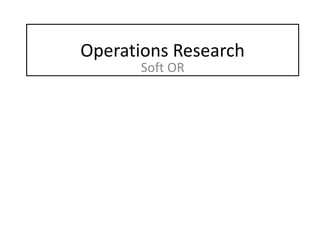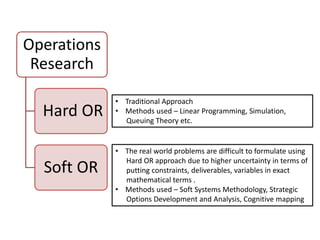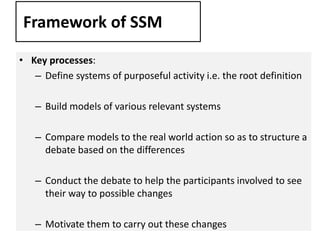Operational Research
- 2. Operations Research Hard OR Soft OR ? Traditional Approach ? Methods used ĻC Linear Programming, Simulation, Queuing Theory etc. ? The real world problems are difficult to formulate using Hard OR approach due to higher uncertainty in terms of putting constraints, deliverables, variables in exact mathematical terms . ? Methods used ĻC Soft Systems Methodology, Strategic Options Development and Analysis, Cognitive mapping
- 3. Differences between the two approaches Dimension Hard OR Soft OR Decision maker(s) Single decision making authority ( individual or group with consensus) Large number of decision makers or groups with conflicting objectives Problem/ Objective Well defined Not defined as large number of decision making authorities makes it difficult to decide upon Critical Factors Easily quantifiable Not quantifiable and thus immeasurable Mathematical Modeling Easy, frequently practiced Extremely infeasible Role of OR specialist Analyst Facilitator between various decision making authorities
- 4. METHODS USED IN SOFT OR Soft OR SODA SSM TOC Causal Maps Scenario Planning Drama Theory Benefits Analysis
- 5. Strategic Options Development Analysis (SODA) ? Developed in the 1970ĄŊs by Colin Eden ? Problem structuring method which helps one to understand the various viewpoints of a problem area ? Tries to channel the cooperation of a variety of stakeholders into addressing a problem ? Takes an individualistic approach i.e. ĻC it takes into account that people behave politically within the organization and ĻC each individual may have different perspective to the problem
- 6. Philosophy of SODA ? Main philosophy: To structure a problem through stakeholder involvement ? Foundation: ĄŪsubjectivismĄŊ i.e. each member of the client group can have his/her own subjective view of the real problem ? Focuses on gathering diverse views about the problem, helping people to refine their views and achieving consensus ? Simple to use, Facilitator dependent ? Used when face to face problem solving in group is essential
- 7. Framework of SODA ? Underlying assumption: organizations are made up of the individuals with different perspectives ? Needs that group formation will ensure enough diversity in the perspectives ? Cognitive mapping and facilitation are the two main techniques used in carrying out SODA
- 8. General steps used in SODA 1. Identify problem/situation and all stakeholders and plan meetings 2. Conduct client interviews in a relaxed unstructured format to get their individual views of the problem/situation 3. Develop the individual cognitive maps to represent each individualĄŊs perception of the problem or situation. 4. Check-back interviews To ensure correct interpretation in the causal maps. If not, modifications are done in the map. 5. Merging the individual maps 6. Present all individual and combined maps and through facilitation the merged map is modified to arrive at the consensus 7. Interpret the merged map in terms of High level goals, mid-level strategies and Low level tactics and operational targets 8. Action selection, allocation and implementation
- 9. Soft Systems Methodology (SSM) ? Developed by Peter Checkland & colleagues in the late 60ĄŊs at the University of Lancaster, UK ? Originally seen as modeling tool, but in later years used more as learning and meaning development tool ? Logic: every problem is like a system and can be understood if compared to reality in a model which can structure debate based on the differences and accordingly necessary changes can be identified
- 10. Philosophy of SSM ? Follows systems thinking as a means of learning and understanding for complex problems ? Problem structuring method more aligned to human activity systems ? Based on the understanding that process of human interaction is equally important as data or the outcome itself ? Applicable to hard as well as soft problems ? Simply provides different method to deal with ĄŪproblematic situationsĄŊ
- 11. Framework of SSM ? Key processes: ĻC Define systems of purposeful activity i.e. the root definition ĻC Build models of various relevant systems ĻC Compare models to the real world action so as to structure a debate based on the differences ĻC Conduct the debate to help the participants involved to see their way to possible changes ĻC Motivate them to carry out these changes
- 12. Classic SSM seven-stage model
- 13. Classic SSM seven-stage model ? Stages need not be carried out in particular sequential order ? Has a barrier in between to distinguish the stages that address real world & others which address Systems thinking ? Stages 2 to 4 are iterative in nature ? Different stakeholders (clients, owners and actors) debate to arrive at feasible, desirable changes ? Techniques used in SSM, which include Rich pictures, PQR formula, CATWOE, conceptual/activity modeling ? doesnĄŊt provide one correct answer, rather it helps one to learn about the problem, design appropriate way forward and understand how it should be delivered. SSM helps understand even to the client the best way to proceed with the project and deliver the required output
- 14. Drama Theory ? Involves application of theatrical models to interactions in everyday life ? Actions of individuals in an episode impacts the outcome of successive episodes ? Solution is said to have been reached when there exist no better alternatives to the current state
- 15. Scenario Planning Identification of the Issue at hand Identification of the Primary driving Forces Identification of the Pre determined elements of the Driving Forces Identification of the Critical Uncertainties Flesh Out Scenarios
- 16. Theory of Constraints (TOC) Identification of the Constraints Decision on How to Exploit the Constraints Subordinating everything else to the Above Decision Elevating the systemĄŊs constraints If the constraint has been broken, repeat the entire process without allowing inertia to cause a constraint
- 17. Benefits Modeling/ Analysis ? Method used to formulate a problem ? Utilizes the idea of a BenefitsĄŊ Map, which represents relationships between investment areas and value criteria Causal Mapping ? Process of creating a causal map to display behaviors, outcomes and interrelationships between them ? Specially preferred in cases where there are multiple paths to specific outcomes
- 18. Thank You !

















